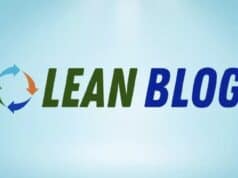I took another look at the “lean obstacles” survey questions, but this time breaking it down by some key demographic factors (more details here):
- Public vs. Private
- Company Revenue
- Organizational Level
Again, I wish had the n=2000+ sample size of the LEI survey. Maybe they will break down their larger survey results in a similar way, releasing that to the world as well. My sample size is small (just over 100), so any conclusions we try to draw from the survey must have the caveat of small sample sizes.
Question 1 was the “choose all that apply” version:
Q1. What are the biggest obstacles to implementing Lean in your organization?
Looking first a Public vs. Private, see the table below (click on any of them for a larger view):
I bolded the three obstacles that had the biggest gap between the private and public companies (which were evenly split in the 104 respondents). Public companies reported more problems with “employee resistance” (45.5% vs. 36.0% of private companies). I wonder if this is more of a function of company size, since public companies tend to be larger than private companies.
Looking at Large Companies (annual revenue > $250M USD) versus Small Companies, see the table below. Looking first at “employee resistance,” there is an even bigger gap, where Large Companies report this problem 48% of the time vs. 28.6% of Small Companies.
There are also large gaps for:
- “Flavor of the Month” (54% of Large vs. 23.8% of Small)
- “Lack of crisis” (42.0% of Large vs. 28.6% of Small)
- “Failure to overcome opposition” (28.0% of Large vs. 11.9% of Small)
All three of those obstacles could also be tied to poor leadership, could they not? Is it harder to rally a larger company around any change, whether that be Lean or other methods? Almost across the board, Large Companies reported MORE obstacles than Small Companies (an average of 4.2 obstacles for Large vs. 3.1 obstacles for Small). This measure was more equal for “Public vs. Private” (3.8 obstacles vs. 3.92 obstacles).
Now, we can also look at the breakdown by level in the organization. I grouped the levels into three groups (which unfortunately had unequal sample sizes):
- Upper: CEO, President, VP, Director (n=21)
- Middle: Manager, Technical Staff, Support Staff (n=72)
- Lower: Supervisor, Front Line Staff (n=20)
I highlighted three obstacles that had interesting differences across those groups (see below):
Looking at “employee resistance,” there was more blame pointed at that direction as you moved DOWN the organization. 25% of Upper level pointed at “employee resistance,” but 43% of Middle level respondents and a striking 56% of Lower level surveys pointed in that direction. Is this natural that you'd tend to point at a direction that you have the most exposure to every day? Do Upper level employees not have any exposure to Lower level employees to know if they are resisting? Same trend applied to “supervisor resistance,” where there was more blame at the bottom of the organization.
“Middle management resistance” was more evenly distributed (so I didn't highlight it).
Looking at “lack of top management support,” the Upper level (55%) and Lower level (44%) pointed more blame at the top than the Middle level did (31%). Interesting. We've wondered here on the Lean Blog before if everyone tended to point up, but Upper management was tougher on themselves than any group.
Lower levels of the organization reported more obstacles (4.67), in general, than did Middle (3.84) or Upper levels (3.75). Remember, each respondent could choose MULTIPLE obstacles that got in the way of Lean.
One other obstacle, hightlighted in green, jumped out: “failure to overcome opposition.” 56% of Lower level respondents and 26% of Middle level respondents said this was an obstacle. But what percentage of Upper level respondents said this? ZERO. 0 of 21. Why do you think this is? Do execs tend to be more optimistic? Is this why they reported fewer obstacles?
What other interesting comparison do you see in the data? What hypotheses would you come up with?
Stay tuned for demographic breakdowns looking at the second question in my survey — which is the TOP obstacle to Lean implementation?? Click on the 5 Whys Survey” link at the bottom of this post to see the other posts on this topic.
Subscribe via RSS | Lean Blog Main Page | Podcast | Twitter @MarkGraban
Please scroll down (or click) to post a comment. Connect with me on LinkedIn.
Let’s build a culture of continuous improvement and psychological safety—together. If you're a leader aiming for lasting change (not just more projects), I help organizations:
- Engage people at all levels in sustainable improvement
- Shift from fear of mistakes to learning from them
- Apply Lean thinking in practical, people-centered ways
Interested in coaching or a keynote talk? Let’s talk.
Join me for a Lean Healthcare Accelerator Trip to Japan! Learn More








This is fascinating analysis here, thanks.
Perhaps the ZERO in obstacles from the Top Management group versus the other levels has something to do with empowerment. Higher levels believe that they are empowered to make changes and to work through or around obstacles. The other levels apparently don’t feel that same empowerment, but it still gets back to management and perception.
Comments are closed.